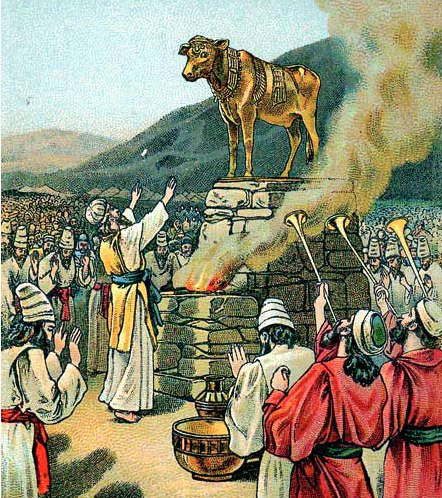S.E.S. Medina
Benbrook, Texas, United States
 |
| Worshiping the golden calf, as in Exodus 32:1-35. Illustration from a Bible card published 1901 by the Providence Lithograph Company. Via Wikimedia. |
“And he took the (golden) calf which they had made, and burnt it in the fire, and ground it to powder, and scattered it upon the water, and made the children of Israel drink of it.” Exodus 32:20.
In the event depicted above, Moses had just returned with the Ten Commandments from Mt. Sinai when he found the Hebrews conducting an orgy around a calf idol cast from their gold jewelry. He angrily seized the golden calf and converted it into drinkable gold, thus becoming the first to create powdered gold, earning him the dubious title of “The First Alchemist.”1 This act of converting gold into an extremely fine powder (nano-particle colloidal suspension) and ingesting it is central to the theory of the Philosophers’ Stone.
Did Moses know how to reduce gold to a powder? In the Bible he is described as fleeing to the land of Midian (Exodus 2:11-15), meeting Jethro, high priest of Midian, and marrying his daughter Zipporah. He may have learned metallurgical technology from his father-in-law.1
Jethro was a Kenite, a people who had migrated from South Asia and brought with them their knowledge of metallurgy. The Kenites settled in a region that extended eastward into northwestern Saudi Arabia, a territory rich with large deposits of gold, silver, copper, lead and tin. As High Priest, Jethro would have overseen the most important temple of the region, the Hathor Temple at Serabit el-Khâdim, which had large-scale smelting and metallurgical facilities. Hathor was only a few miles away from Mount Sinai, and Moses would have been familiar with it because the Egyptians had a robust trade with metallurgists. In ancient times, vast amounts of gold were transported to Hathor for processing. This suggests that Moses possessed the technological know-how to convert the golden calf to nano-particle gold.1
According to the alchemist Paracelsus, who championed the Ars Brevis method, Moses would have used a metallurgical rather than chemical process to produce the nano-particle gold:1
(Gold) + 3(Antimony/Stibnite) → (Heat) → (Purified Gold) + 3(Evaporated Antimony↑)
This technique is repeated twelve times, yielding a red powder (nano-particle gold), the Philosophers’ Stone.2 Historical records show that gold preparations were used as therapy for thousands of years in Western and Eastern Cultures. The Chinese used it as an alchemical drug for longevity.1
The medicinal form of colloidal gold (the Philosophers’ Stone) was called Aurum Potabile (“gold that is safe to drink”), a combination of antimony and gold fabled to give the drinker perfect psychiatric and physical health, unlocking deeper intelligence, mental faculties, and granting inner spiritual strength.1, 2 Indian-Hindu medicine has claimed for thousands of years that traditional preparations containing gold6, 7, 8 have antioxidant and rejuvenating properties, promote longevity, and slow aging.7, 8
Kashyapa, a revered Vedic sage of Hinduism, stated the ingesting gold augmented intellectual abilities, improved digestive and metabolic function, increased stamina, was an aphrodisiac, and prolonged life.4 Hindus referenced Hiranya (synonymous with Swarna Bhasma), in the prehistoric Vedic works 1-2 (~2000-1500 BC).4, 5 One ancient therapeutic form of Indian nano-particle gold is known as Swarna Bhasma (“incinerated gold”).9 The ancient Ayurvedic recipe9 to purify gold was to remove impurities (Shodhan), grind it with water to reduce particle size (Bhavna), and incinerate it at high temperature to further reduce its caliber (Maran). The Bhavna and Maran treatments were repeated multiple times. The resulting reddish-brown powder was further ground until extremely fine, 50-60 nm in diameter, yielding Swarna Bhasma, which is absorbed in the gut and reaches the tissues.10
Given the use of gold to alleviate neurologic and psychiatric afflictions such as epilepsy and depression, Moses may have given colloidal gold to the disobedient Hebrews as a mood-altering substance. Was he using it to discipline them or as a psycho-spiritual medication? The biblical account does not tell us.
References
- Laport JE, Gabrielsson R. Cracking the Philosophers’ Stone: Origins, Evolution and Chemistry of Gold-Making. Quintessence Publishing. 2009.
- Medina SES. The Philosophers Stone: History and Myth. Hektoen International Journal. August 8, 2020; https://hekint.org/2020/08/04/the-philosophers-stone-history-and-myth/
- Mahdihassan S. Cinnabar-Gold as the Best Alchemical Drug of Longevity, called Makaradhwaja in India – American Journal of Chinese Medicine. 1985; 13: 93-108.
- Sravani K, et al. A Review on Traditional Ayurvedic Preparations Containing Gold. International Journal of Pharmacognosy and Phytochemical Research. 2017; 9(6); 801-807.
- Saper, Robert B., et.al. Heavy Metal Products Content of Ayurvedic Herbal Medicine. JAMA. 2004; 292 (23): 2868‐73.
- Sharma H, Chandola HM, Singh G, Basisht G. (2007). Utilization of Ayurveda in Health Care: An Approach for Prevention, Health Promotion, and Treatment of Disease, the Science of Life. 13(9), 1011-9.
- Mitra A, et al. Evaluation of Chemical Constituents and Free-Radical Scavenging Activity of Swarna Bhasma (gold ash): an Ayurvedic Drug. J Ethnopharmacol. 2002:80: 147-53.
- Sharma Sadanand, Rasa Tarangini, 11th edition, Varanasi: Motilal Banarsidas 1979: chapter 15:70, chapter 15:11-116.
- Sravani K, et al. A Review on Traditional Ayurvedic Preparations Containing Gold. International Journal of Pharmacognosy and Phytochemical Research. 2017: 9(6); 801-807.
- Hillyer J F, et al. Gastrointestinal Persorption and Tissue Distribution of Differently Sized Colloidal Gold Nanoparticles. J Pharm Sci. 2001 Dec; 90(12): 1927-36.
S.E.S. MEDINA, MD, is a retired Internal Medicine specialist with a sub-specialty in Infectious Diseases. His initial medical training took place at the New York University School of Medicine in the late 1970s when the AIDS epidemic was just beginning, working with severely ill HIV infected patients. Clinical research under Dr. Linda Laubenstein during his fourth year at the NYU Medical School resulted in a contributing paper which was included in the first medical textbook on AIDS.
Dr. Medina would like to acknowledge the creative and editorial contributions of his nephew and godson, David I. Banchs, in the writing of this piece.

Leave a Reply